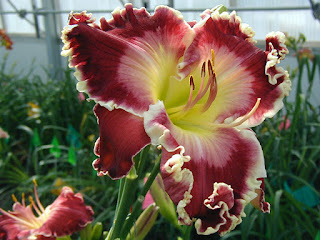In keeping with my goal this year of producing a larger percentage of plants with great outside hardiness and budcount, 11 of the 13 of my most planted pod parents are current or future introductions which are proven parents. I also had a lot more of those plants to work with.
The most planted pod parent was All Things to All Men, with 31 different pollen parents. Although I have used it for several years, it is an amazing parent and wanted to put it with things that I hadn't yet tried (like Get Jiggy, Bluegrass Memories, Vanishing Mist, Alpha and Omega, God Save the Queen and a bunch of my new seedlings.

The fifth most used was Not Guilty (with 15 pollen parents). Love the way it passes on its color to its kids.

The sixth most used, also with 15 pollen parents, was Skin of My Teeth. I put it on toothy things like Terrible Swift Sword and Thistles and Thorns and tall, toothy, rose colored 24312 (see earlier in the blog).

The seventh most used, also with 15 pollen parents, was Forty Days and Forty Nights - because it is very tall and dormant with good budcount. I used it with mostly super fancy pollen parents to give them better plant habit.
The eighth most used was Alpha and Omega (with 14 pollen parents). Love the color and the eye and the genetics, and haven't used it before since it was always an outside plant and I forgot to collect its pollen.

The ninth most used was 13107 (with 14 pollen parents) for its hardiness and proven performance as a parent.
The tenth most used was Repeat the Sounding Joy (with 11 pollen parents), because of its proven performance as a parent of hardy kids that are introduction worthy.

The 11th most used was seedling 4812 (with 10 pollen parents) - and this is going to look like a very odd choice based on its "face". But as a 9 month seedling it was super tall, 7", had 6 way branching with well-spaced laterals, was super pod fertile, and had genetics (out of Not Guilty, 8305 which includes Gnashing of Teeth, Faith That Moves Mountains, Chariot of Clouds, Skin of My Teeth - oh, my! these are hardy and all great parents). So I put it with super fancy things to give them great plant habit.
The twelfth most used (with 9 pollen parents) was Vanishing Mist. I haven't used it since I first saw it many years ago and then sent outside for testing, and would have used it more this year but all the plants but my one were spoken for. It breeds wonderful chalky eyes.
The thirteenth most used (also with 9 pollen parents) was Soli Deo Gloria. I used it with Thistles and Thorns, Faith that Moves Mountains, Vino di Travis, Bluegrass Memories, 24312, etc.












































